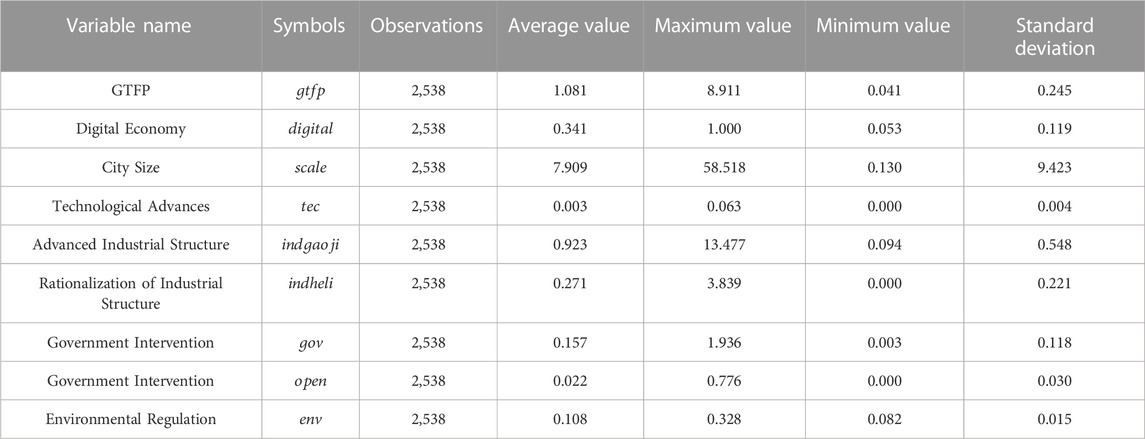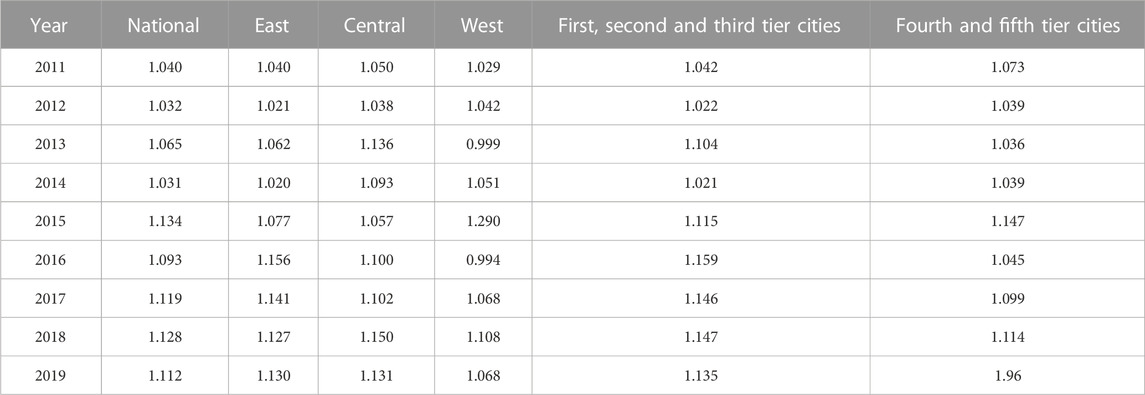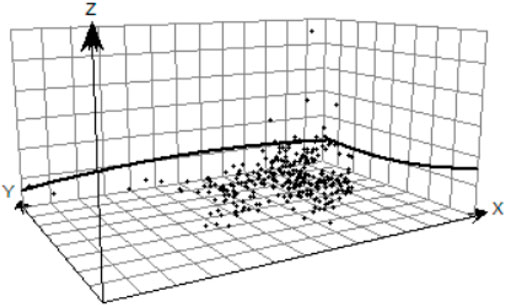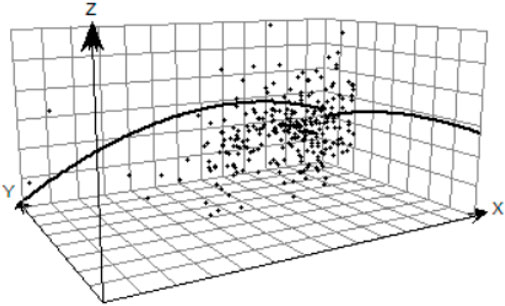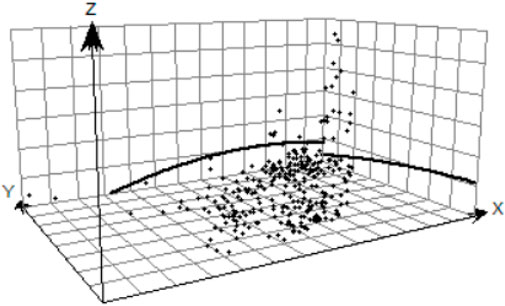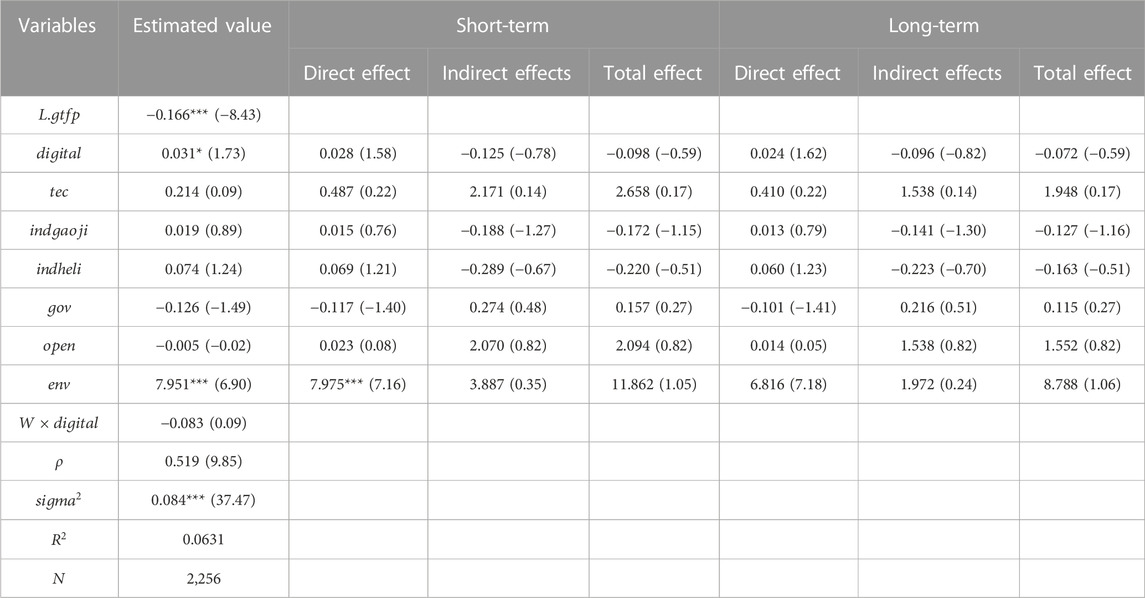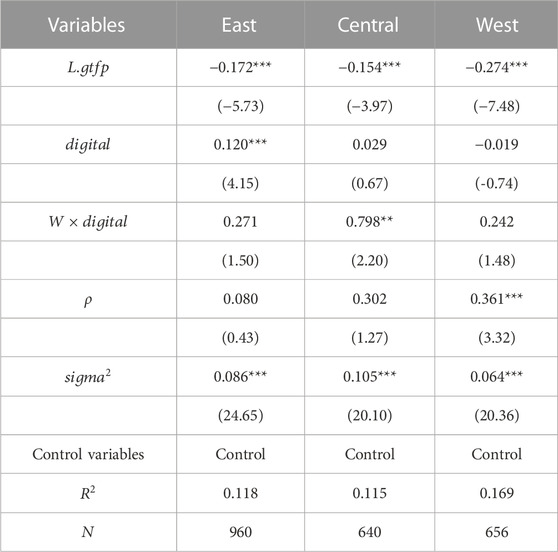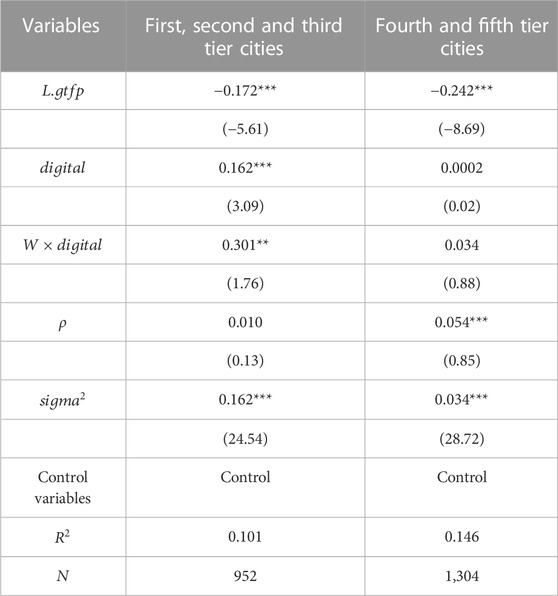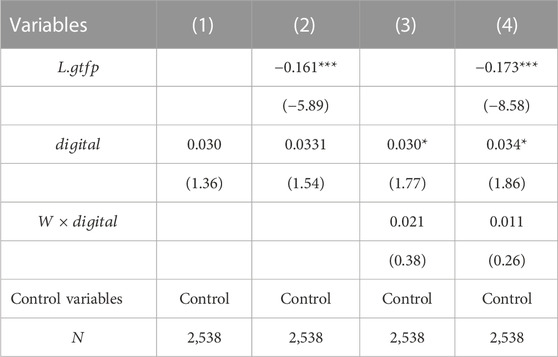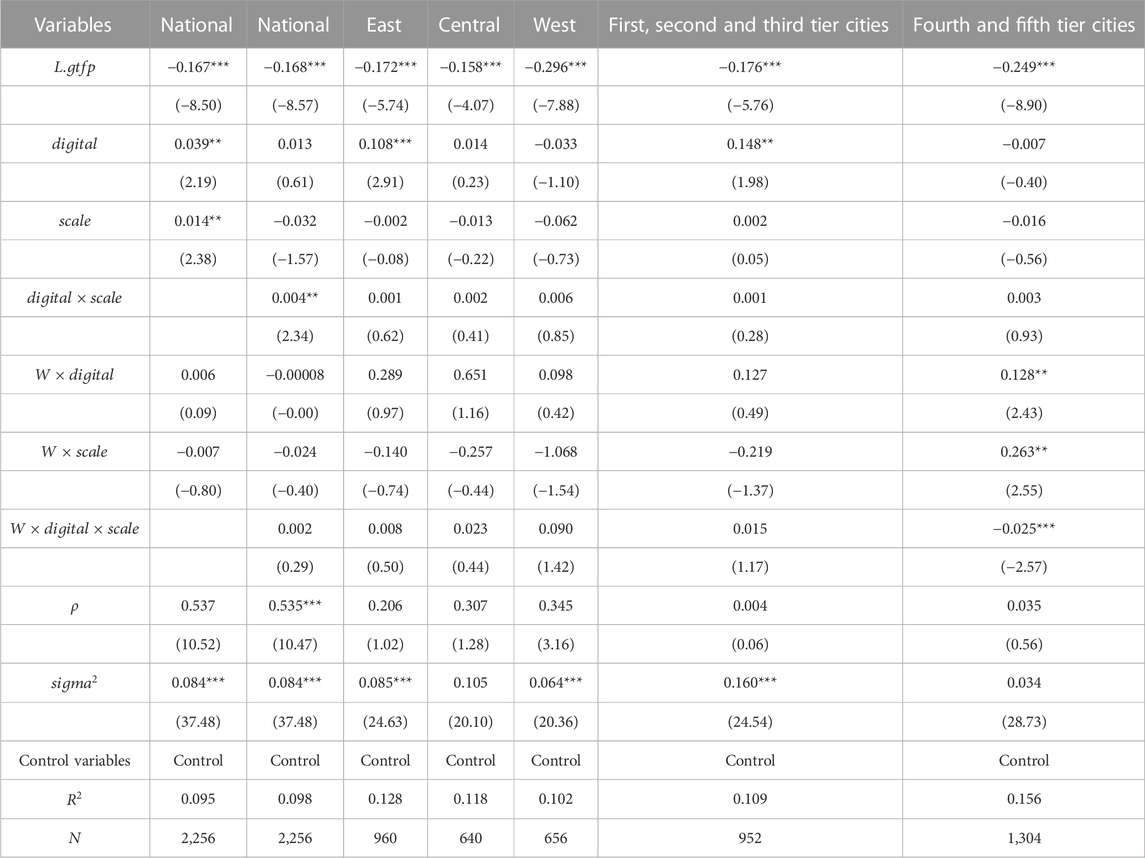Effects of digital economy and city size on green total factor productivity
- School of Business Administration, Zhongnan University of Economics and Law, Wuhan, China
Utilizing the digital economy’s contribution to green total factor productivity is a key strategy for accelerating China’s green growth, although more research is still needed to understand the mechanism of this influence. This study uses panel data from 282 Chinese prefecture-level cities from 2011 to 2019 to empirically assess the impact of the digital economy and city size on GTFP. First, GTFP overall exhibits an upward trend with excellent spatial correlation and minimal regional variation. Second, the findings demonstrate that, while surrounding locations’ GTFP is not affected by the digital economy, local productivity can be improved. Third, the heterogeneity study demonstrates that the digital economy contributes more to local GTFP in the eastern region compared to the central and western regions, with the central region making the largest contribution to GTFP in the surrounding regions; the first, second, and third tier cities have more contributions from the digital economy to local and neighboring GTFP than the fourth and fifth tier cities. Fourth, city size positively modifies the relationship between the green total factor productivity and the digital economy. The western region is where the positive moderating effect of city size expansion is greatest. Moreover, compared to first-, second-, and third-tier cities, the fourth- and fifth-tier cities have a stronger beneficial moderating effect of city size increase. In light of this, we should focus on the growth of the digital economy, optimize city scale, and fully exploit the scale effect produced by the concentration of the digital industries and the spillover effect produced by the spread of the digital technology.
1 Introduction
The level of green economic development is directly reflected in GTFP, and increasing GTFP is in line with the practical requirements of China’s new development philosophy. China has made significant progress in its economic and social development since the reform and opening up, but it also faces a number of challenges, including environmental pollution, an aging population, an energy crisis, and high carbon emissions. Chinese digital economy has advanced to a new stage of deeper application, standardized development, and sharing for the benefit of everyone thanks to the deep integration of the digital economy and many fields in recent years. Accelerating the development of the digital economy is a significant way to address the challenging issues in the current development pattern, support Chinese high-quality development, and increase total factor productivity in this context as it is a key driving force for development in the new era. Therefore, one of the crucial academic themes of the present is investigating whether the digital economy can encourage the improvement of GTFP and by what mechanism it will boost GTFP.
Cities serve as the foundation of the national economy and are crucial to the advancement of sustainable and high-quality development. A significant factor in the process of the digital economy producing social repercussions is the breadth and depth of urban scale transformation. The future green and high-quality growth of Chinese cities will focus on developing the new green engine of the digital economy and urban scale transformation as well as exploring the new path of these factors that enable green development. In light of this, this paper explains how the digital economy and city scale affect GTFP and empirically analyzes the connection between the digital economy, city scale, and GTFP using panel data from 282 prefecture-level cities from 2011 to 2019. The goal is to provide a theoretical foundation for relevant departments to develop targeted policy measures in the context of modernization. On the basis of this, the paper’s minor contributions are as follows. In order to analyze the respective roles and synergistic effects of the digital economy, city size, and GTFP in fostering GTFP growth, this article first integrates these three variables into a single analytical framework. Second, using spatial econometric models, 282 prefecture-level Chinese cities are utilized as empirical samples to examine the effects of the digital economy and city size on the GTFP.
2 Literature review
GTFP research is currently divided into two main areas. One of the elements is the measurement approach, in which researchers mostly use the SBM model-GML index to measure GTFP from an input-output perspective (Feng et al., 2018). The other aspect entails the research on the identification and role of the influencing factors that affect GTFP. The identified influencing factors can be categorized as economic development, ecological environment, and government policies. The economic development mainly includes market mismatch, technological innovation, OFDI, etc. According to empirical findings by Zhang et al. (2019), market mismatch hampered the expansion of GTFP in 33 countries along the Belt and Road from 1995 to 2012. Using panel data for the OECCD countries from 1996 to 2017, Wang H. et al. (2021) demonstrate that technical innovation has a strong positive impact on GTFP. Data from 21 European countries that took part in the Belt and Road Initiative from 2009 to 2018 are used by Xie and Zhang (2021), and the empirical findings indicate that China’s OFDI helps these nations’ GTFP increase. The ecological environment aspects are mainly related to environmental pollution and its management. The findings of Li et al. (2022) demonstrated that severe air pollution does not raise GTFP in agriculture. According to Tong et al. (2022), China’s GTFP is greatly increased by stringent environmental rules. Further, government policies become an important basis for enhancing GTFP, such as the construction of national e-commerce demonstration cities, fiscal decentralization, carbon emission trading pilot, and pilot free trade zones, all of which have significant impacts on GTFP (Song et al., 2020; Cao et al., 2021; Wang A. et al., 2022; Yu et al., 2022).
Academics have focused their attention on the difficult economic activity of how to harness the force and rules of the digital economy to improve GTFP. Most research on the subject of the digital economy and GTFP agree that it has a good impact on the latter, although there are some variations between their conclusions, which primarily come from two points of view. One is that the development of GTFP can be directly influenced by the digital economy. Based on panel data from 108 cities in the Yangtze River Economic Zone from 2011 to 2019, the study by Hu and Guo (2022) demonstrates that the digital economy significantly increases GTFP. Second, the relationship between the digital economy and GTFP is U-shaped or inverted U-shaped. Meng and Zhao (2022) demonstrate that there is a specific threshold value for the impact of the digital economy on GTFP using panel data from 17 manufacturing industries from 2000 to 2014. The positive impact of the digital economy on GTFP is negligible before to exceeding the threshold, but it can dramatically increase GTFP after exceeding the barrier. According to Li et al. (2020), the encouragement of green technology advancement by the digital economy is the key source of the digital economy’s impact on GTFP, which has a substantial U-shaped characteristic.
Cities serve as the fundamental building block of the national economy and are crucial to the high-quality growth of the digital economy. In the process of creating social consequences in the digital economy, the change in city size is crucial. City size and digital economy are interconnected and influence each other. On the one hand, the growth of the digital economy is based on city size. According to Pradhan et al. (2021), urbanization is a crucial foundation for the advancement of information and communication technology, which supports the growth of the digital economy. On the other side, the transformation of city size will be accelerated by the digital economy. The findings of Zhu and Chen (2022) demonstrate that the digital economy has a greater influence on urban space than urbanization. Academics have not yet reached consensus on the research findings about the connection between city size and GTFP, and there are three basic points of view. One is the promotion theory, which holds that increasing city size contributes to an increase in GTFP. The growth of city size is advantageous to the enhancement of GTFP, according to empirical findings from Peng et al. (2020) measurement of the level of GTFP in the nations that make up the Silk Road economic belt. The second is the suppression theory, which holds that increasing city size is bad for increasing GTFP. According to Xie et al. (2022), the mismatch of land resources brought on by rapid urban development prevents the growth of GTFP. There is a threshold for the contribution of city size expansion to GTFP, according to the third theory, which is nonlinear. The research by Tan et al. (2022) demonstrates that when the economic agglomeration is relatively modest, the impact of urban transportation infrastructure on GTFP change is not considerable, but it becomes clear as the agglomeration rises.
Although the literature now available is adequate, there are a number of issues. First, the present literature is mostly concerned with the mechanism and impact of the digital economy on GTFP at the local level; however, not enough studies have been done to pinpoint the precise mechanisms through which the digital economy influences GTFP at the local level of cities. Second, the existing studies on the external effects of the digital economy and city size assume that the relationship between the two factors and GTFP is linear. Yet, the spatial implications of the digital economy and city size on GTFP need for greater consideration in light of the spatial externality hypothesis. In order to provide workable policy recommendations, this study first integrates the digital economy, city size, and GTFP into a single analytical system for theoretical analysis. Then, it uses a spatial econometric model to empirically analyze the effect of the digital economy on GTFP and the moderating role of city size in this process.
3 Theoretical mechanisms and research hypotheses
3.1 Digital economy and GTFP
The digital economy is a critical component that offers a new strategic fulcrum for China’s economic transition since it is redefining global factor resources, the global economic structure, and the global competitive environment. Thus, China’s economy can change from being a factor-driven economy to an efficiency-driven and innovation-driven one, and it can exhibit a modern economic development path; consequently, the changes that affect power, efficiency, and quality provide a new growth path for GTFP.
First, the digital economy creates power shifts that impact GTFP through influencing developments in technology, models, and institutions (Chen, 2022b). The digital economy has fundamentally changed the way traditional sectors produce goods by leveraging cutting-edge technology in fields like big data, artificial intelligence, cloud computing, and high-end equipment manufacture. Innovation in digital technology increases the organic momentum of green economic development in addition to providing the technical foundation for data to become a revolutionary production technique and a key production element. Secondly, the digital economy via “Internet +” for the innovation of traditional industrial development mode, and for the promotion of digital recording, storage, interaction, and sharing of fundamental high-quality data resources across various industries, which indirectly improves productivity, promotes the quality and efficiency of traditional industries, and creates momentum for the intelligent and green development of industries. Finally, for the digital economy to develop, the government should facilitate the development of an environmental supervision system that is based on digital technology, which will effectively promote institutional innovation, accelerate the construction of a robust network that will transform China’s economy into a digital economy, provide environmental support and policy support that is compatible with the form of the digital economy that the country will develop, encourage the development of a novel green and low-carbon development pattern and enlist the aid of institutional innovation funds that prioritize the improvement of GTFP.
Second, the digital economy encourages efficiency change and increases GTFP through improving production efficiency and factor allocation efficiency (Zhang et al., 2022). On the one hand, the economies of scale, scope, and long-tail effect of the digital economy can help businesses get around several institutional and technological constraints that prevent the improvement of production efficiency. Additionally, businesses can use digital technology to streamline operations, improve operational effectiveness, reduce resource waste, and cut expenses associated with transactions. As a result, business vitality is boosted, competitiveness is increased, and enterprise green transformation and development are accomplished. On the other hand, the digital economy has opened up the channels for the production factors’ circulation; continually led the supply, value, and industrial chains, which made it possible to allocate resources efficiently using the internet; facilitated coordination and innovation among various industrial sectors; and yielded novel industrial forms such as the platform economy, sharing economy, “virtual” industrial parks, and industrial clusters; thus, the digital economy can help to further advance GTFP.
Third, the digital economy fosters quality change by raising the quality of factors, goods, and services, leading to GTFP growth (Wang M. et al., 2021). The digital economy produces significant changes in production relations and lifestyles through data factorization and factor datafication; reshapes the factor input structure that characterizes the original economic system, which in turn enhances factor quality, facilitates the development of a novel model for developing the digital economy, which exhibits a multi-level structure, wide coverage, differentiation, and the rational division of labor among large, medium, and small enterprises; and promotes the development of China’s green economy. Furthermore, the quality and mode of supply of goods and services have undergone significant changes as a result of the digital economy, which enables enterprises to transform their products and services using digitalization and to promote the mode of supply from single to multiple, the motive from management to service, the content from rough to fine, the mode from decentralized to collaborative, and the performance evaluation from closed to open; thus, enterprises provide consumers with more digital products and with personalized and customized services. Therefore, the digital economy responds to the growing desire for a better living and raises total green factor productivity.
Based on the aforementioned study, we put up the following hypothesis (Hypothesis 1): the digital economy helps to positively boost GTFP.
3.2 City size and GTFP
The major ways that city size influences GTFP are through the agglomeration economic effect caused by the concentration of production factors, the technology spillover effect caused by technological advancement, and the structure-driven effect caused by the modernization of industrial structures.
First, when a city’s population changes, agglomeration-based economic effects frequently follow, having a significant impact on GTFP (Cheng et al., 2022). In the early stages of urbanization, factors of production such as industries, talents, capital, and innovation activities are heavily invested in urban construction, which generates agglomeration effects, and the city scale becomes rapidly widened, which offers strong support for the modernization of the urban industrial structure, technological advancement, and economic growth; hence, city size aids in the ongoing improvement of urban GTFP. However, as the scale of cities continues to expand, the congestion effect that modifies the urban scale inhibits the growth of GTFP, the population and industries over-concentrate in cities, and the disorderly expansion of the urban space occurs.
Second, variations in city size offer an essential conduit for the information diffusion that impacts technological innovation, which affects the expansion of GTFP (Wang KL. et al., 2022). In terms of cities and towns, as economic and population scales increase, people, businesses, and industries are more likely to share resources, information, and markets. The diversified and specialized clustering of industries also changes how factor inputs are shared, which supports the growth of the green economy. The expansion of cities on a suitable scale can improve the quality of the labor force, the quality of the innovation factors, and provide enough capital to support technical innovation and knowledge spillover, thereby promoting GTFP. The information spillover effect that influences technological innovation will be lessened by the chaotic growth of city size; as a result, the improvement of GTFP will not be assisted.
Third, changes in city size result in sophisticated industrial structures, and the rationalization and advancement of these structures have an impact on GTFP (Cheng and Jin, 2022). During scale expansion, cities can guide and adjust the general layout of industries based on their own factor endowments and competitive advantages. The concentration of production factors encourages the emergence and growth of numerous industrial parks, which encourages the transformation of the industrial structure from agriculture to industry and services, low-level to high-level, and quantitative to qualitative. It also encourages the development of the urban industrial structure, which encourages GTFP. The spatial planning and element resetting that characterize the process of urban scale change can assist industry complementarity and mutual support, modify and optimize the industrial distribution pattern, and promote the ongoing extension and expansion of the industrial chain. Additionally, it can support the efficient use of resources, ease the change of the city’s old-new dynamics, allocate resources and spatial components in the best way possible, and assist the orderly transformation of the economic development mode. Consequently, element resetting and spatial planning support the rationalization of the change in urban scale. Hence, improving GTFP is facilitated by rationalizing the industrial structure.
Based on the aforementioned study, we put up the following hypothesis (Hypothesis 2): the improvement of GTFP is facilitated by a proper city scale.
3.3 Digital economy, city size, and GTFP
In general, as development levels rise, which have an impact on the digital economy, cities will get larger, which in turn will fuel the expansion of the digital economy; thus, the digital economy and city size are correlated. Four theories are primarily used to explain how digitalization and city size interact to affect GTFP.
According to the first theory, the digital infrastructure’s characteristic leapfrogging promotes GTFP growth (Pan et al., 2022). Cities support the simultaneous development of urbanization and informatization, which widens and deepens the application scenarios of digital infrastructure, by creating digital infrastructure, scaling up communication network construction, and boosting the capacity of communication services; hence, the master plan for the optimization of city scale is affected. As a result, the foundation for the growth of the digital economy, which guarantees that people’s lives are improved, is digital infrastructure. As a result, numerous fields will see an acceleration of the digital revolution, which will continuously improve digital governance, support the upgrading and transformation of the regional economy, and provide a strategic, ground-breaking, and essential foundation for increasing GTFP.
According to the second theory, GTFP is promoted by the accelerated improvement of digital industries’ potential for innovation (Qiu et al., 2021). Regarding the digital economy, the expansion of city scale creates opportunities for innovation, and the improvement of digital industry innovation capacity accelerates the application of digital technology to traditional industries. This motivates real businesses to increase their investment in information technology, get past technical hurdles, improve their information analysis skills, and address industrial bottlenecks. The gradual maturity of businesses results in increased security and stability when it comes to the use of digital technology in the industrial and supply chains, whereas the city’s innovation-driven development strategy, which supports the growth of the digital economy and its radiation-driven capability, adds additional vitality and momentum that can boost GTFP.
Third, increasing GTFP is facilitated by the acceleration of digital industrialization and industrial digitization (Zhang and Zhou, 2022). Industrial digitization is the use of digital technology by established industries to innovate and transform, whereas digital industrialization refers to the creation of new industries and economic sectors based on digital technology. The rapid growth of digital industrialization and industrial digitization encourages the fusion and expansion of traditional industries and digital technologies as well as the exact balancing of supply and demand, blurs the boundary between traditional industrial sectors, transforms the mode of coupling digital information and production factors, facilitates the release of the agglomeration economic effect and the urban growth potential that is occasioned by urban scale expansion, promotes the rational layout of traditional industries and digital industries in urban space, and assists cities in promoting GTFP through a thorough, high-quality development process.
According to the fourth theory, the digitalization of public services encourages urban growth. The digital transformation of public services promotes the enhancement of GTFP (Thanh, 2022). Public services are an essential building block for the development of green cities; however, the separation of administrative responsibilities across cities, competing interests, and high transaction costs impede their integration, which in turn has a detrimental effect on the improvement of GTFP. By taking the initiative to direct the diffusion and application of digital technology in public services, the government can support the digital transformation of urban public services, eliminate “fragmented governance” and administrative hurdles between cities, support the integration of public services between central and local governments, improve its capacity to transform the scale of cities, and reshape the administration and quality of public services, thus contributing to promote GTFP.
Based on the aforementioned study, we put up the following hypothesis (Hypothesis 3): the connection between digitalization and city size is beneficial to improving GTFP.
4 Model setting and indicator construction
4.1 Measurement model setting
By constructing a spatial econometric model that takes into account the digital economy, city size, and GTFP, this study experimentally analyzes the relationship between the three. In order to decrease the potential endogenous influence of the dynamic change process of the variables on the estimation results, the dynamic spatial Durbin model is used in this research to conduct the empirical analysis. The specific model parameters are as follows:
Considering Eq. 1, the explanatory variable
This research introduces the interaction term of the digital economy (
4.2 Variable selection and measurement
4.2.1 Explained variable
We construct an SBM-Malmquist productivity index model (
4.2.2 Explanatory variable
Digital economy (
4.2.3 Adjustment variable
City size (
4.2.4 Control variables
1) Technological progress (
4.3 Data sources
The China City Statistical Yearbook and the Digital Finance Research Center of Peking University provided the majority of the data that we used to measure the digital economy. We used the evening lighting data (DMSP/OLS and NPP/VIIRS) that the National Oceanic and Atmospheric Administration (NOAA) supplied from 2011 to 2019 to estimate the size of cities. The descriptive statistics for the variables are shown in Table 1.
5 Regression results
5.1 Temporal characterization of GTFP
Table 2 displays the annual average GTFP values for the nation and individual cities from 2011 to 2019. Table 2 shows that there is a varying upward tendency in the annual average values of GTFP as a whole. By regions, the annual mean values of GTFP in eastern and central regions are higher than those in western regions, and the annual mean values of GTFP in first-, second- and third-tier cities are higher than those in fourth- and fifth-tier cities, demonstrating that areas with greater economic development are better able to increase GTFP than areas with lesser levels of economic development.
5.2 Spatial correlation analysis
Table 3 shows the Moran indices we developed to investigate the regional autocorrelation of the digital economy, city size, and GTFP. Table 3 shows that the global Moran index is significantly positive, with the exception of a few years. Consequently, there is a significant spatial relationship between the size of the city, the GTFP, and the digital economy, which emphasizes the requirement and sense of using a spatial econometric model to research this problem.
5.3 Trend analysis
We create 3D perspective views of the digital economy, city size, and GTFP using a “trend analysis” tool that was created using ArcGIS software; the corresponding images are shown in Figures 1–3. The Z-axis points to the properties, the Y-axis points to the north, and the X-axis points east. Figure 1’s fitted curve for GTFP shows a decreasing East-West trend, and a “U”-shaped north-south curve shows that regional variations in GTFP are not significant. Figure 2’s fitted curve for the digital economy shows a west-to-east growing tendency as well as a North-to-South increasing trend, both of which point to high levels of development in China’s east and south. Figure 3 shows that the fitted curve for city size rises and follows an East-West and North-South axis, indicating that the West and South of China have large cities.
5.4 Analysis of spatial measurement results
The geographic econometric correlation test is used in this paper to evaluate the appropriateness of applying the dynamic spatial Durbin model, and the specific outcomes are displayed in Table 4. There is no multicollinearity among the variables used for this paper, as shown by the VIF test findings in Table 4. The dynamic spatial Durbin model used in this work is known to be plausible based on the findings of the LR test and Wald test.
The findings of the spatial effect decomposition appear in columns 2 through 7, while the results of the dynamic spatial Durbin model based on the geographic distance matrix appear in the first column of Table 5. The results of Table 5’s first column show that the estimated coefficient of GTFP (
Among the control variables, the positive estimated coefficient of technological progress (
Based on Table 5’s direct, indirect, and total effects in the short and long terms, as well as the predicted spatial spillover effects of the main explanatory factors. The estimated coefficients of the spatial lag of the digital economy (
5.5 Heterogeneity analysis
Based on the geography of their provinces, the 282 cities in this study were split into eastern, western, and central areas. The results are displayed in Table 6. Table 6 shows that the eastern region has the biggest positive digital economy (
Table 7 displays the findings of the classification of 282 cities into Tier 1, 2, 3, 4 and 5 cities. According to Table 7, Tier 1, 2, and 3 cities have larger positive coefficients for digital economy (
5.6 Robustness test
This paper conducts robustness tests using least squares estimation OLS, systematic GMM, static spatial Durbin model, and the use of economic distance matrix in four different ways. The specific results are displayed in columns (1)–(4) of Table 8 in the order in which they were obtained. Table 8 demonstrates that the estimated results of the primary explanatory variables are less different from the previous article in terms of coefficient values and significance, further demonstrating that the regression results of this paper are more reliable.
5.7 Test and analysis of interaction effects
Based on the previous work, this paper adds an interaction term between the two to investigate if the digital economy and city size have a synergistic impact on green total factor production. The precise findings are displayed in Table 9.
When the interaction term is removed from the results in column 1 of Table 9, the positive correlations for the city size (
6 Conclusion and recommendations
This research experimentally examined the relationship between digital economy, city size, and GTFP using a spatial econometric model, based on the panel data of 282 prefecture-level cities in China from 2011 to 2019, and came to the following conclusion. First, GTFP exhibits a yearly rising trend generally, with excellent spatial correlation and minimal regional variation. Second, the digital economy is advantageous for improving local GTFP, but not for improving GTFP in nearby locations. Third, the eastern region’s digital economy is more suited to boosting regional GTFP than the central and western regions’ are, and the central region’s digital economy is more suited than the eastern and western regions to boosting GTFP in the surrounding areas. Comparatively to fourth- and fifth-tier cities, the digital economy in first-, second-, and third-tier cities is more suited to boosting GTFP in the region and its surrounding areas. Fourth, additional research reveals that the city size of the digital economy can increase GTFP, with the western area moderating the influence of city size more positively than the eastern and central regions. Additionally, in terms of city size, the fourth and fifth tier cities moderated the effects more favorably than the first, second, and third tier cities.
Based on the findings discussed above, this study proposes the following suggestions. First, it is underlined how important it is for the growth of the digital economy and city scale optimization to support the promotion of GTFP enhancement. The development of digital economy can provide effective support for the green and low-carbon transformation of urban economy through scale effect, spillover effect, and universal sharing, and thus promote the growth of GTFP. Second, it is important to address the local conditions when addressing the effects of the city size and the digital economy on GTFP. To advance the GTFP, individual cities should execute distinct digital economy development strategies based on their level of economic growth and orderly encourage the fusion of the digital economy with new urbanization. Third, it is important to properly acknowledge the beneficial effects of optimizing city size in the process of the digital economy’s influence on GTFP. It is essential to actively encourage the use of digital technology during the process of new urbanization construction because this gives cities a digital technology foundation to improve their capacity for green development, optimizing the scale of cities and encouraging the improvement of GTFP.
Data availability statement
The raw data supporting the conclusion of this article will be made available by the authors, without undue reservation.
Author contributions
ZL contributed to conception and design of the study. JL and YY conducted the data analysis, wrote the original draft. XZ edited the paper. All authors contributed to the article and approved the submitted version.
Funding
This research was funded by the Fundamental Research Funds for the Central Universities, Zhongnan University of Economics and Law (No. 202311020).
Acknowledgments
The authors would like to thank KetengEdit (https://www.ketengedit.com) for linguisticassistance during the preparation of this manuscript.
Conflict of interest
The authors declare that the research was conducted in the absence of any commercial or financial relationships that could be construed as a potential conflict of interest.
Publisher’s note
All claims expressed in this article are solely those of the authors and do not necessarily represent those of their affiliated organizations, or those of the publisher, the editors and the reviewers. Any product that may be evaluated in this article, or claim that may be made by its manufacturer, is not guaranteed or endorsed by the publisher.
References
Cao, X., Deng, M., and Li, H. (2021). How does e-commerce city pilot improve green total factor productivity? Evidence from 230 cities in China. J. Environ. Manage 289, 112520. doi:10.1016/j.jenvman.2021.112520
Chen, P. (2022a). Is the digital economy driving clean energy development? New evidence from 276 cities in China. J. Clean. Prod. 372, 133783. doi:10.1016/j.jclepro.2022.133783
Chen, P. (2022b). Relationship between the digital economy, resource allocation and corporate carbon emission intensity: New evidence from listed Chinese companies. Environ. Res. Commun. 4 (7), 075005. doi:10.1088/2515-7620/ac7ea3
Cheng, Z., and Jin, W. (2022). Agglomeration economy and the growth of green total-factor productivity in Chinese Industry. Socio-Econ Plan. Sci. 83, 101003. doi:10.1016/j.seps.2020.101003
Cheng, Z., and Li, X. (2022). Do raising environmental costs promote industrial green growth? A quasi-natural experiment based on the policy of raising standard sewage charges. J. Clean. Prod. 343, 131004. doi:10.1016/j.jclepro.2022.131004
Cheng, Z., Li, X., Zhu, Y., and Wang, M. (2022). The effects of agglomeration externalities on urban green total-factor productivity in China. Econ. Syst. 47, 101025. doi:10.1016/j.ecosys.2022.101025
Feng, C., Huang, J. B., and Wang, M. (2018). Analysis of green total-factor productivity in China's regional metal industry: A meta-frontier approach. Resour. Policy 58, 219–229. doi:10.1016/j.resourpol.2018.05.008
Fukuyama, H., and Weber, W. L. (2010). A directional slacks-based measure of technical inefficiency. Socio-Econ Plan. Sci. 43 (4), 274–287. doi:10.1016/j.seps.2008.12.001
Gu, B., Liu, J., and Ji, Q. (2022). The effect of social sphere digitalization on green total factor productivity in China: Evidence from a dynamic spatial Durbin model. J. Environ. Manage. 320, 115946. doi:10.1016/j.jenvman.2022.115946
Hu, X., and Guo, P. (2022). A spatial effect study on digital economy affecting the green total factor productivity in the Yangtze River Economic Belt. Environ. Sci. Pollut. Res. 29 (60), 90868–90886. doi:10.1007/s11356-022-22168-9
Li, H., Tang, M., Cao, A., and Guo, L. (2022). Assessing the relationship between air pollution, agricultural insurance, and agricultural green total factor productivity: Evidence from China. Environ. Sci. Pollut. Res. 29 (52), 78381–78395. doi:10.1007/s11356-022-21287-7
Li, T., Han, D., Ding, Y., and Shi, Z. (2020). How does the development of the internet affect green total factor productivity? Evidence from China. IEEE Access 8, 216477–216490. doi:10.1109/access.2020.3041511
Lin, B., and Chen, Z. (2018). Does factor market distortion inhibit the green total factor productivity in China? J. Clean. Prod. 197, 25–33. doi:10.1016/j.jclepro.2018.06.094
Meng, F., and Zhao, Y. (2022). How does digital economy affect green total factor productivity at the industry level in China: From a perspective of global value chain. Environ. Sci. Pollut. Res. 29 (52), 79497–79515. doi:10.1007/s11356-022-21434-0
Pan, W., Xie, T., Wang, Z., and Ma, L. (2022). Digital economy: An innovation driver for total factor productivity. J. Bus. Res. 139, 303–311. doi:10.1016/j.jbusres.2021.09.061
Peng, Y., Chen, Z., Xu, J., and Lee, J. (2020). Analysis of green total factor productivity trend and its determinants for the countries along silk roads. Growth Change 51 (4), 1711–1726. doi:10.1111/grow.12435
Pradhan, R. P., Arvin, M. B., and Nair, M. (2021). Urbanization, transportation infrastructure, ict, and economic growth: A temporal causal analysis. Cities 115, 103213. doi:10.1016/j.cities.2021.103213
Qiu, W., Zhang, J., Wu, H., Irfan, M., and Ahmad, M. (2021). The role of innovation investment and institutional quality on green total factor productivity: Evidence from 46 countries along the “Belt and Road”. Environ. Sci. Pollut. Res. 1-15, 16597–16611. doi:10.1007/s11356-021-16891-y
Song, K., Bian, Y., Zhu, C., and Nan, Y. (2020). Impacts of dual decentralization on green total factor productivity: Evidence from China’s economic transition. Environ. Sci. Pollut. Res. 27, 14070–14084. doi:10.1007/s11356-020-07953-8
Tan, R., Pan, L., Xu, M., and He, X. (2022). Transportation infrastructure, economic agglomeration and non-linearities of green total factor productivity growth in China: Evidence from partially linear functional coefficient model. Transp. Policy 129, 1–13. doi:10.1016/j.tranpol.2022.09.027
Thanh, T. T. (2022). Effects of digital public services on trades in green goods: Does institutional quality matter? J. Innov. Knowl. 7 (1), 100168. doi:10.1016/j.jik.2022.100168
Tong, L., Jabbour, C. J. C., Najam, H., and Abbas, J. (2022). Role of environmental regulations, green finance, and investment in green technologies in green total factor productivity: Empirical evidence from Asian region. J. Clean. Prod. 380, 134930. doi:10.1016/j.jclepro.2022.134930
Wang, A., Hu, Y., Li, Y., Rao, S., and Lin, W. (2022a). Do pilot free trade zones improve the green total factor productivity? Evidence from a quasi-natural experiment in China. Environ. Sci. Pollut. Res. 29 (50), 75307–75321. doi:10.1007/s11356-022-21003-5
Wang, H., Cui, H., and Zhao, Q. (2021a). Effect of green technology innovation on green total factor productivity in China: Evidence from spatial durbin model analysis. J. Clean. Prod. 288, 125624. doi:10.1016/j.jclepro.2020.125624
Wang, K. L., Pang, S. Q., Zhang, F. Q., Miao, Z., and Sun, H. P. (2022b). The impact assessment of smart city policy on urban green total-factor productivity: Evidence from China. Environ. Impact Asses 94, 106756. doi:10.1016/j.eiar.2022.106756
Wang, M., Pang, S., Hmani, I., Hmani, I., Li, C., and He, Z. (2021b). Towards sustainable development: How does technological innovation drive the increase in green total factor productivity? Sustain Dev. 29 (1), 217–227. doi:10.1002/sd.2142
Wu, Y., Shi, K., Chen, Z., Liu, S., and Chang, Z. (2021). Developing improved time-series DMSP-OLS-like data (1992–2019) in China by integrating DMSP-OLS and SNPP-VIIRS. IEEE Trans. Geosci. Remote Sens. 60, 1–14. doi:10.1109/tgrs.2021.3135333
Xie, F., and Zhang, B. (2021). Impact of China’s outward foreign direct investment on green total factor productivity in “Belt and Road” participating countries: A perspective of institutional distance. Environ. Sci. Pollut. Res. 28, 4704–4715. doi:10.1007/s11356-020-10849-2
Xie, R., Yao, S., Han, F., and Zhang, Q. (2022). Does misallocation of land resources reduce urban green total factor productivity? An analysis of city-level panel data in China. Land use policy 122, 106353. doi:10.1016/j.landusepol.2022.106353
Yu, Z., Mao, S., and Lin, Q. (2022). Has China’s carbon emissions trading pilot policy improved agricultural green total factor productivity? Agriculture 12 (9), 1444. doi:10.3390/agriculture12091444
Zhang, C., Chen, P., and Hao, Y. (2022). The impact of digital transformation on corporate sustainability-new evidence from Chinese listed companies. Front. Environ. Sci. 10. doi:10.3389/fenvs.2022.1047418
Zhang, C., and Zhou, W. (2022). New direction of sustainable urbanization: The impact of digital technologies and policies on China’s in situ urbanization. Buildings 12 (7), 882. doi:10.3390/buildings12070882
Zhang, Q., Yan, F., Li, K., and Ai, H. (2019). Impact of market misallocations on green TFP: Evidence from countries along the Belt and Road. Environ. Sci. Pollut. Res. 26, 35034–35048. doi:10.1007/s11356-019-06601-0
Keywords: digital economy, city size, GTFP, spatial measurement, spatial spillover effects
Citation: Liu Z, Liu J, Yin Y and Zhu X (2023) Effects of digital economy and city size on green total factor productivity. Front. Environ. Sci. 11:1225406. doi: 10.3389/fenvs.2023.1225406
Received: 22 May 2023; Accepted: 11 July 2023;
Published: 26 July 2023.
Edited by:
Evgeny Kuzmin, Ural Branch of the Russian Academy of Sciences, RussiaReviewed by:
Pengyu Chen, Dankook University, Republic of KoreaLev Mazelis, Vladivostok State University of Economics and Service, Russia
Copyright © 2023 Liu, Liu, Yin and Zhu. This is an open-access article distributed under the terms of the Creative Commons Attribution License (CC BY). The use, distribution or reproduction in other forums is permitted, provided the original author(s) and the copyright owner(s) are credited and that the original publication in this journal is cited, in accordance with accepted academic practice. No use, distribution or reproduction is permitted which does not comply with these terms.
*Correspondence: Jiandong Liu, jdliu9955@126.com
 Zejie Liu
Zejie Liu  Jiandong Liu
Jiandong Liu